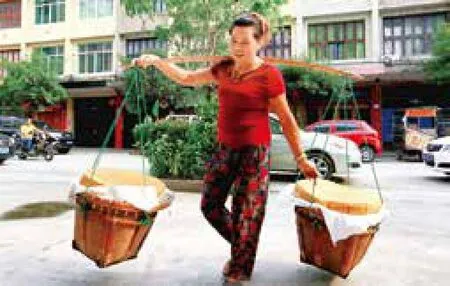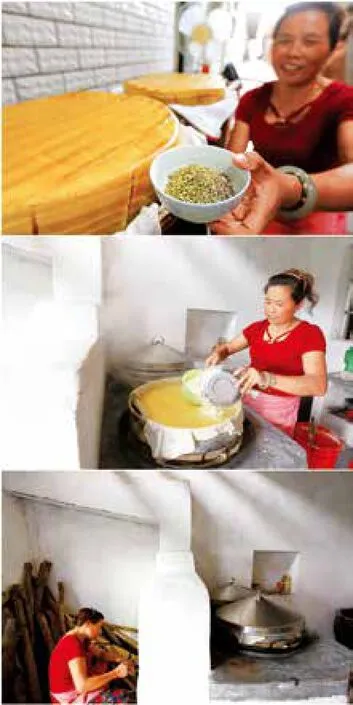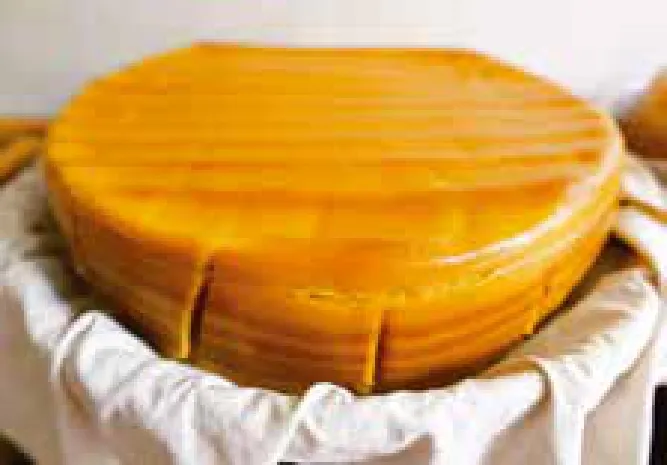Traditional Cakes in Rui’an
By Rui Yimin
Traditional Cakes in Rui’an
By Rui Yimin
Fuling Cake is a traditional delicacy made in the South Gate region in downtown Rui’an, a county-level city in southern Zhejiang Province. The fragrance of the cake is quite familiar to local residents. The bakery makes the steamed cake and sells them off immediately to queuing consumers. The hot delicacy is popular.
The technique for making the cake has recently been inscribed as an intangible cultural heritage of Wenzhou.

林美珠担着竹箩去菜市场出售九层糕。Lin Meizhu goes to the market to sell her cakes.
Fuling Cake has been around for 150 years in the region. As legend has it, originally it was made in the court kitchen for court ministers in the early morning before they met the emperor. In the late Qing Dynasty (1644-1911), Gao Changfa, a cake-maker in Rui’an,improved the recipe by adding powdered Fuling to the sweetened bean paste, which is a big part of the cake. The added ingredient is a herb, which, according to the theory of traditional Chinese medicine, promotes health and retains youthfulness, eliminates dampness, removes heat from the lung, and resists fatigue. For this new addition, Gao changed the name to Fuling Cake.

着色加植物槐黄。(上图)米浆要一层一层加,(中图)在大镬灶用木柴烧,才能保留传统风味。A local herb is added to give the cake a color. The rice paste is added layer by layer and steamed on a firewood oven.
Fuling cake is part of the pastry made of rice flour extremely popular in the south of China. Zhejiang boasts quite a few such rice cakes and rice-flour puddings. It is said that Fuling cake originally came from the south of Fujian, a province to the south of Zhejiang. It presumably became what it is today in the last years of the Ming (1368-1644) or the early years of the Qing. Even today, you can find peddlers sell this delicacy in Xiamen, a port city in southern Fujian.
“Gao Changfa” Fuling cake now popular in Rui’an started four generations ago. Gao Changfa was the startup entrepreneur. Gao Peizhen (1866-1956) was the family’s second-generation Fuling cake maker. The third-generation master was Gao Jingsong (1937-2005). Now the family tradition is in the hands of Gao Qina born in 1967. She is a designated master of this intangible cultural heritage of Rui’an.
According to Gao Qina, the secret of the Fuling cake is in its recipe, delicate making process and choice ingredients. The recipe says what kind of three types of rice must be used and how much each type must go into the mixed flour. Ingredients for the stuffing include fine sugar, sesame, raisin, and sugared white gourd. A special design is printed on the cake and then the large dough is cut into pieces 8 centimeters long and 6 centimeters wide. These pieces go into a wood lattice frame structure, 20 pieces for a frame. One frame can be placed upon another before they are steamed. Steaming goes for fifteen minutes, the cake sends off a strong aroma and looks white and yummy.
Usually patrons come to the shop and wait. At a recent gourmet festival in Rui’an, Gao Qina sold 700 cakes within an hour on the first day. On the second day, 2,000 pieces were sold within two hours. Local residents just love Gao Changfa.
Gao Qina says that her pastry shop supplies the cake to local restaurants and hotels across Rui’an with Gao Changfa Fuling cake on a daily basis.
Nine-Layer Cake
Nine-Layer Cake is a traditional snack in Rui’an. The 51-year-old Lin Meizhu, a resident of the village of Yangkeng in Rui’an, makes and sells 200 kg of Nine-Layer Cake a day for a whole week every Zhongyuan Festival in July on the lunar calendar.
Zhongyuan Festival is an important celebration around Rui’an in southeastern Zhejiang. Local people offer sacrifices to ancestors and report this year’s harvest to ancestors. The cake, made of rice just harvested, is a must.

层匀美观,乳香甜润的九层糕Nine-layer cake is also a delicacy of Rui’an.
Lin says the nine-layer cake is no longer just for sacrificial ceremony around the Zhongyuan Festival. People want it on many other occasions: when it is Chongyang Festival on September 9 on the lunar calendar, when college admission letters arrive for high school graduates, when village celebrations take place, people buy the cake and share it with relatives and friends. The cake suggests best wishes for future.
Making the nine-layer cake is a complicated traditional craft. Nowadays, only about 10 households in Yangkeng Village and neighboring Dongchuan Village are still engaged in the business. Lin feels sorry for the situation. She wonders whether some publicity campaign can raise the public’s awareness of the craft on the verge of extinction.
One of the most important steps of the cake making is to steep the new rice in the straw-ash liquid for three hours until the rice became brown. Nowadays, however, she no longer uses straw ashes as rice straw is not easy to find. She makes the liquid with a TCM ingredient, which she buys from a local TCM pharmacy. After three hours, the rice is ready to be ground. She uses an electricity-powered steel grinder to make the rice paste and mix it with brown sugar or refined white sugar. The cake must be made within half an hour after the paste is ready. One layer is about 0.5 centimeter thick and usually she makes 10 to 20 layers into a cake. Then she uses a large wok to steam the cake. Steaming takes more than 3 hours.

